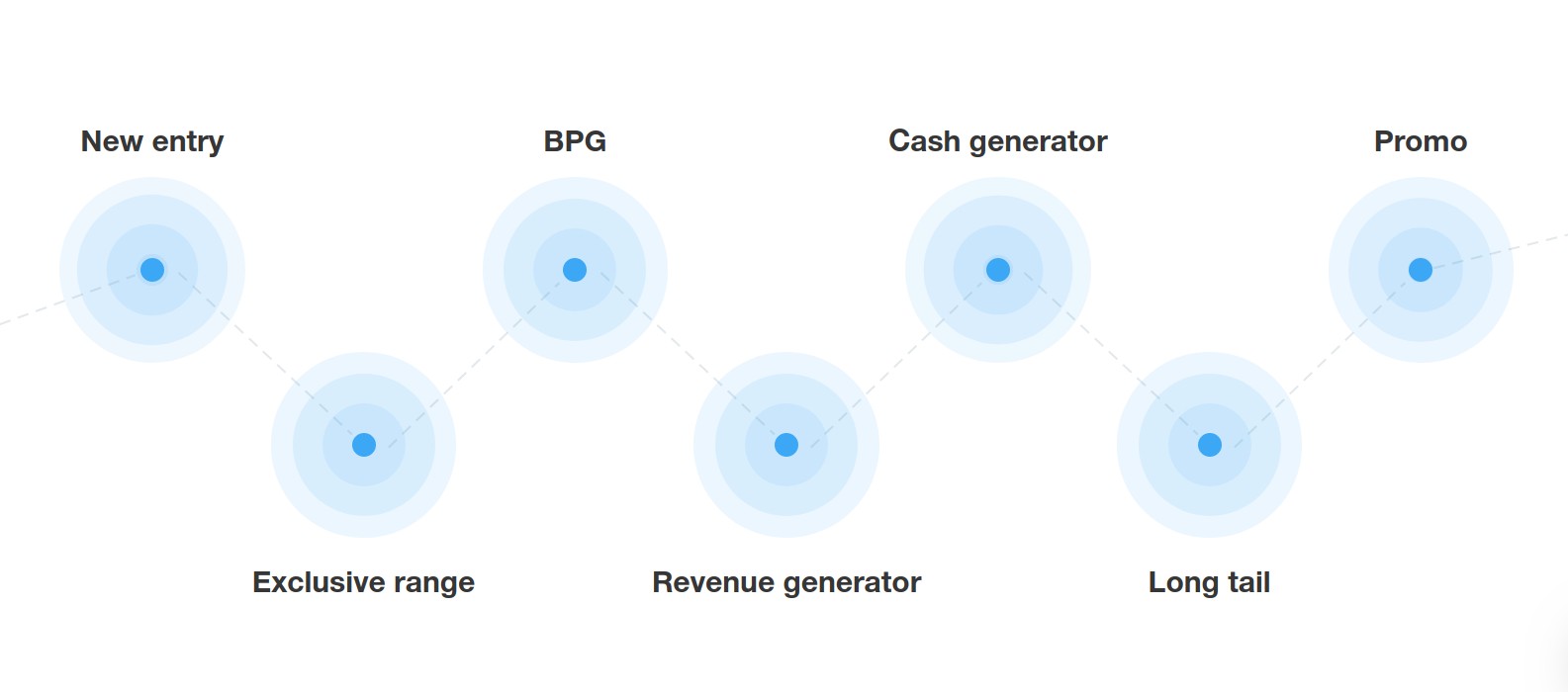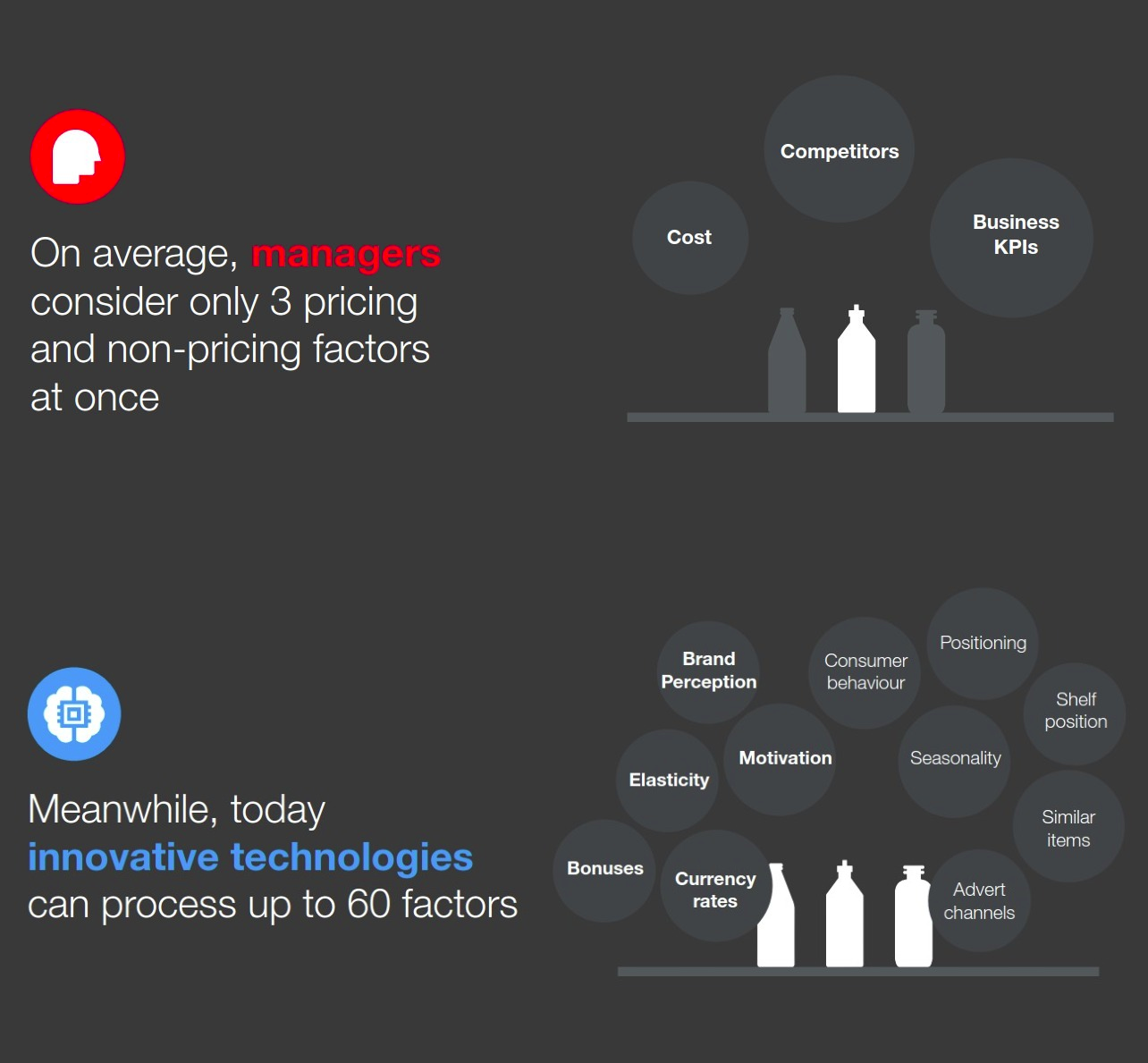Content navigation:
- What is category management?
- Category management process from A to Z
- Best practices in category management
- New Normal category management checklist
- 1. Ensure supply chain is sustainable
- 2. Reconsider growth engine model
- 3. Shift to portfolio-based pricing
- 4. Automate category management tasks
- 5. And again: rely on technology
What is category management?
Category management is a strategic process used by retailers to organize procurement and segment products into different groups in order to increase business efficacy and gain strategic goals. Category management definition implies organizing SKUs into groups of similar or related products, so they can be supplied and priced as an integrated entity.
Product category management is a process implying an organization of stock-keeping units or SKUs into separate categories based on particular characteristics. Once the products are grouped into categories, coherent pricing, promo, and marketing strategy is applied by the category management team to make sure the business goals and targets are achieved.
Category managers or simply catmans may organize product categories based on various SKU characteristics. Most often, these include similar features, yet they may also cover the value, volume, or supplier type. The Pareto principle and ABC Analysis belong to the methods that are most commonly used by catmans while dividing the assortment into categories.
Category management examples refer to various types of similar products grouped by a retailer for the sake of more effective management. Every business uses its specific classifications to divide the portfolio into categories. To give examples, in electronics, typical categories may include TV & video, cell phones, mobile phones, home appliances, computers, tablets, or headphones.
The major benefits of category management stem from the fact that the process enables retailers to align and organize the procurement and supply chain in the most effective and sustainable way by maximizing the key business metrics in the long run. Besides, the proper category management strategy may serve as a powerful means of scaling effective practices, which is especially relevant for large retailers operating globally.
Category management definition and process
Category management is a complex process that can be divided into a dozen of expertise areas that every catman is more or less often dealing with. Here are just a few examples of such areas:
- External negotiations with vendors and suppliers
- Internal communication with pricing analysts, C-level managers, etc.
- Continual market and competition analysis
- Procurement strategic management
- Demand analysis and planning
- Category managers team leadership
The list of areas that catmans should have expertise in is not limited to the list outlined above, yet it gives a high-level impression of the processes underlying category management. In terms of daily operational activities, category managers deal with the following processes:
- Define the category of an SKU. A category is not stable as suppliers change and new products appear on the market. The right determination of the product's category means that the right tools will be applied to manage the product life on the shelf.
- Strategic planning and goals setting. After the categories are defined, it is necessary to set objectives aligned with the retailer's positioning and business targets.
- Control and monitoring. The efficiency of category management is gained through the daily monitoring of KPIs achievement progress and SLA control.
- Pricing. Category managers work closely with pricing managers or analysts. Together they analyze the demand, identify the cross-sales dependencies within the portfolio, and craft final prices.
Best Practices in Category Management
Want not only to know category management definition but rather make it a source of competitive advantage? This advice is right what you need.
First and foremost, treat category management as the art of strategically organizing products and services to maximize efficiency, profitability, and customer satisfaction.
In today's dynamic market landscape, an efficient category management process is not just an option; it's a necessity for businesses aiming to stay competitive and relevant. To navigate this terrain effectively, adopting best practices and implementing advanced category management software solutions is crucial. Let's delve into the key practices that can pave your way for success in category management.
1. Make Data-Driven Decisions
Data serves as the basis for the effective category management process. By leveraging advanced analytics and insights, businesses can capitalize on consumer preferences and purchasing behaviors, as well as other market trends. Using category management software solutions utilizing the vast amount of data, decision-makers can optimize assortments, pricing strategies, and promotional activities tailored to meet customer demands.
2. Communicate and keep collaborative
Effective category management thrives on collaboration across departments. Establishing open lines of communication between procurement, marketing, sales, and other relevant teams is pivotal for succeeding with category management strategy. Regular cross-functional meetings and workshops encourage brainstorming and innovation across the departments.
3. Stay customer-centric
Putting the customer at the heart of the category management process is paramount. Understanding the needs, preferences, and pains of consumers enables retailers to manage portfolio in a way that resonates with target audiences. Personalization, tailored promotions, and seamless shopping experiences enhance customer satisfaction, driving loyalty and sustainable growth.
4. Constantly re-evaluate the process
The market is ever-evolving and without a proactive approach to category management, you can hardly stay ahead of competitors. Regularly assessing performance metrics, monitoring competitor activities, and staying abreast of industry trends allow swift adaptation to changing dynamics. Flexibility and agility are key attributes in maintaining a competitive edge in today's fast-paced business environment.
5. Prioritize relationships with suppliers
Strong partnerships with suppliers are integral to an effective category management strategy. Nurture relationships built on trust, transparency, and mutual benefit. Collaborate closely with suppliers to optimize assortments, negotiate favorable terms, and capitalize on emerging opportunities. A win-win relationship with suppliers contributes to innovation, cost efficiencies, and ensures product availability to always meet the demand.
6. Be a technology pioneer
Embracing top-notch category management software solutions revolutionizes the industry by streamlining processes and enhancing decision-making capabilities. Implementing advanced software solutions for inventory management, demand forecasting, and data analytics empowers retailers to make informed decisions swiftly. Use solutions powered by artificial intelligence and machine learning to unlock deeper insights and improve the category management process.
7. Remain sustainable
Integrating sustainable practices into category management process not only aligns with corporate social responsibility but also resonates with eco-conscious consumers. Opt for ethically sourced products, minimize waste through efficient inventory management, and explore eco-friendly packaging solutions. Is there a better way to remain attractive in consumers' eyes? Right, sustainability in retail management has no alternatives.
8. Track KPIs and other key metrics
Establishing key performance indicators is essential for tracking the success of both old and new category management practices. Metrics such as sales growth, margin improvement, inventory turnover, and customer satisfaction provide valuable insights into performance effectiveness. Regularly review KPIs, identify areas for improvement, and recalibrate strategies accordingly to drive continuous growth and success.
New Normal category management checklist
Above we've outlined the essential processes and expertise areas underlying category management. Most of these processes remain unchanged for the last decade. However, global economic trends and crises impacting retail are also transforming the traditional category management patterns forcing managers to look for new tools that will help them to reach goals in spite of the economic and financial turbulence.
As the technology is gaining popularity in the industry, the ability to manage ML-powered software will soon be an indispensable part of a pricing or category manager’s job description. There’s simply no way around it, as it gives managers the unprecedented level of precision and speed of decision-making across any number of products.
In this regard, the recent crisis provoked by the COVID-19 pandemic has turned out to be a real game-changer in category management. The pandemic has undermined the supply chain cycle as well as conventional consumer behavior patterns. As a result, the retail's New Normal was shaped. One of the most distinctive features of the New Normal is a drastically increasing share of purchases made online.
The global shift to online shopping and, eventually, an increasing price transparency force managers to look for new ways of managing categories enabling the business to satisfy the consumer requests and protect the core metrics. Let's see how catmans can become winners of the retail New Normal.
1. Ensure supply chain is sustainable
The recent crisis revealed the vulnerability of many retailers' supply chains. The managers that used to work with a single supplier of a particular product have suffered the most. As logistics, warehousing, and other related processes were undermined, many catmans turned out to be unable to reach the targeted service level and provide customers with the necessary quantity of demanded products.
Of course, category managers cannot control the logistics and other processes on the supplier's side. Yet, every manager is capable of diversifying the supply chain network to make sure that even if a single vendor fails to provide the product, it will be substituted by another supplier. Another thing category managers should start doing in retail's New Normal is sustaining the product delivery process.
Before the crisis, catmans paid little if any attention to the delivery services as it was considered to be rather supplementing service playing an insignificant role in the shopping experience. Now, when online shopping is thriving, smooth and timely delivery becomes one of the most important factors impacting purchasing decisions. What it means is that delivery management becomes another important process that catmans should prioritize.
2. Reconsider growth engine model
The increasing popularity of online shopping means that SKUs are likely to move through the lifecycle stages more promptly. As SKU roles are changing, category managers should also reconsider the growth engine model more frequently.
Three core elements of the growth engine in retail include availability, awareness, and relevance. The right balance between every element is the catman's key to effective category management in the New Normal. As many markets are still going through turbulence, catmens should put more efforts to ensure the product's availability. To find more on how the growth engine changes during the crisis, watch the video below.
Choosing the right growth engine balance is essential to secure the category goals and protect key business metrics. But to find the right blend of growth tools, it is primarily important to identify every product's role in the portfolio. Now, let's talk about portfolio-level thinking in more detail.
3. Shift to portfolio-based pricing
One of the major obstacles preventing category managers from reaching their business targets and gaining repeatable success is the SKU-based pricing approach. Before going into detail, it is necessary to note that the price remains the core factor considered by shoppers while making purchases. And now, in a time of increasing price transparency, the importance of making the right pricing decisions becomes even more significant.
So, what does portfolio-level pricing mean? As we've mentioned already, the roles that the product may play within the category or portfolio are different. Depending on role and lifecycle stage, the following types of SKU are identified most frequently: new entries, SKUs under markdown or promo, exclusive items, revenue generators and traffickers, profit generators, and long-tail products.

Main types of SKU
After the role of every product is defined, a catmen can choose the right blend of market positioning and pricing tools. The question is how to properly identify product roles? And that's where advanced pricing software, like Competera, comes into play. To get some examples, read the story of a large electronics retailer that has managed to increase gross profit by 4.5% after shifting to portfolio-based pricing with Competera.
4. Automate category management tasks
We've mentioned how important it is for category managers to keep focused on strategic goals. At the same time, the true fact is that most of the catmans have no time for strategic thinking as they are constantly dealing with the operational manual tasks. In the time of retail's New Normal, you can win only strategically. That's why the automation of category management tasks has no alternative.

Example of an automated pricing decision tree
Pricing is probably the most effective domain to illustrate the effectiveness of automation in retail. At Competera, we help category managers not only to reduce manual work and save time while repricing but also to optimize costs spent on competitive monitoring. Right before the COVID-19 outbreak, Wiggle Chain Reaction Cycles asked us to automate the repricing process and improve competitive coverage and now the company is gaining even more benefits than it was expected.
5. And again: rely on technology
The last recommendation is probably self-evident, yet we must emphasize it again due to its crucial importance. The last global economic crisis has accelerated the trends dominating for the last few years. And the increasing role of advanced technology is definitely one of those trends. The phrase "Innovate or Die" which became popular after the 2009 recession has never been so close to reality as it is now.

Manual vs. ML-driven decision-making in pricing
There is a room category management software solutions use in every process at every stage. However, we believe that it is best to start with the pricing. The numbers in case studies mentioned above may serve as the best evidence to illustrate the point. Competera Pricing Platform gives the first results in less than 60 days after integration. Now, when you know what is category management, it's time to leave your contacts and we will show more ways in which you can stay effective with Competera.
FAQ
Category management is a strategic process used by retailers to organize procurement and segment products into different groups in order to increase business efficacy and gain strategic goals.
Most often CatMans deal with external negotiations with vendors and suppliers; internal communication with pricing analysts and stakeholders; continual market and competition analysis; procurement strategic management; demand analysis and planning; category managers team leadership.







